2021 Ford Figo automatic: what is it?
What you see here is the third evolution of the Ford Figo automatic. Originally launched in 2015 with an 110hp, 1.5-litre, four-cylinder petrol engine and a dual-clutch transmission, the Figo auto was redone in 2019 with a new 123hp, 1.5-litre, three-cylinder petrol unit that came mated to a 6-speed torque converter auto gearbox. The latter version was discontinued for the BS6 era earlier last year, and the long overdue replacement has just gone on sale and is the subject of this review. The latest Figo auto features the same 6-speed torque converter auto gearbox but comes powered by a smaller, 96hp, 1.2-litre, three-cylinder petrol engine. The use of the smaller engine qualifies the Ford for tax benefits available to sub-four-metre cars with petrol engine displacement less than 1,200cc, and resultantly, the pricing has been favourably realigned too. The promise is of torque converter smoothness for AMT money.
2021 Ford Figo automatic: what is it like on the outside?
The Figo automatic carries the same styling that debuted on the facelifted model from 2019. The ‘Cellular’ grille design, the clean front bumper with the C-shaped fog light housing, and the slightly sportier rear bumper make the Figo look contemporary enough. Notably, the diamond-cut, 15-inch alloy wheels are part of the BS6 update. On the whole, the Figo still looks smart and well-proportioned.
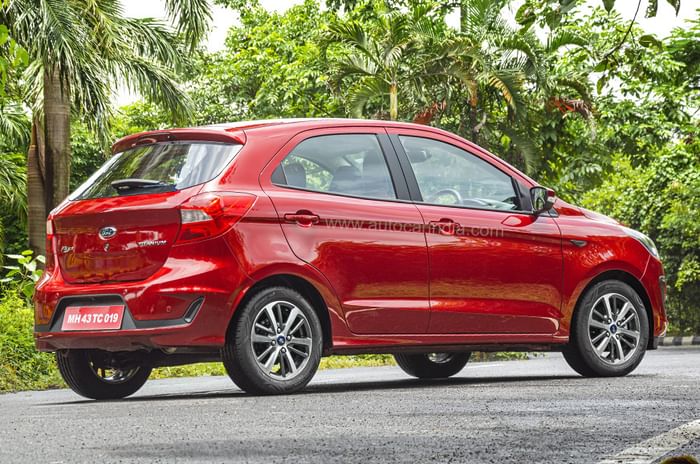
2021 Ford Figo automatic: what’s it like on the inside?
Stepping inside, you’ll see that here, too, everything has stayed the same as the facelifted car. The cabin has an all-black theme, with piano black inserts on the dashboard, steering wheel, gear lever surround and door panels that give it a more premium look (but are fingerprint magnets). The dashboard itself has a layered design, though its overall layout is showing its age. For example, the tray above the 12V socket – ideal for placing you phone while charging – is not nearly large enough to accommodate many phones we use today.

The free-standing, 7.0-inch touchscreen infotainment system takes centre stage on the dash, and while it responds well to touch and is relatively straightforward to operate, the interface looks basic. More importantly, it misses out on Android Auto and Apple CarPlay connectivity, which is something that even more affordable cars offer. AUX connectivity, Bluetooth and embedded navigation are part of the package.
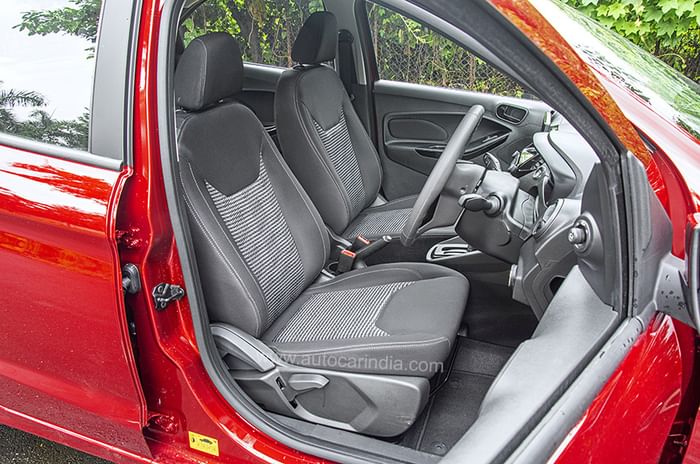
Up front, the seats are comfortable and offer good levels of cushioning and under-thigh support. The driver’s seat height adjust should help you find a comfortable driving position, though telescopic steering adjustment would have been appreciated. The view out is quite good with no major blind-spots, though the small rear-view mirrors (while effective for their size) leave room for improvement.

The rear seats also offer good under-thigh support, with good amounts of knee room – courtesy of the scooped-out backs of the front seats. However, the backrest is a touch upright, which when paired with the tapering roofline means headroom for taller passengers will be tight. Its 257-litre boot isn’t the largest in the segment and its high loading lip means putting in big bags will take more effort.
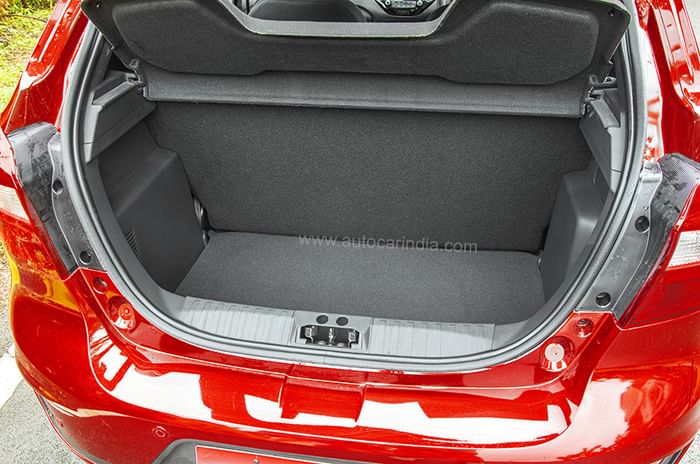
On the equipment front, the Figo automatic is available in the mid-spec Titanium and top-spec Titanium+ trims. The equipment list is headlined by class-leading safety features like six airbags and electronic stability control. Comfort and convenience features include automatic climate control, rain sensing wipers and auto headlamps, push-button start/stop, a rear parking camera and electric release for the tailgate via key fob or switch in the cabin (no physical release present on the tailgate, which can be a bit annoying). Modern amenities like LED headlights, keyless entry, a wireless charger, rear AC vents and a cooled glove box are missing, however.

While the Ford Figo has not been rated on crash safety by Global NCAP as yet, it’ reassuring to know that its sedan sibling, the Aspire, secured a 3-star safety rating from GNCAP back in 2017. For reference, the Figo’s chief rivals, the Maruti Suzuki’s Swift and Hyundai’s Grand i10 Nios, were both rated 2 stars on crash safety.
2021 Ford Figo automatic: how does it perform?
Engage ‘D’ on the auto 'box and you’ll find that the Figo gets going smoothly, owing to its well-executed creep function. Initial responses to the accelerator, however, tend to feel a bit rushed and this calls for very precise pedal modulation in stop-go traffic. It’s not AMT abrupt, so to speak, but it’s not quite torque converter slick either.
Things get better as you build speed. The 6-speed torque converter goes through the gears smoothly and feels nicer than the AMTs offered on rivals. Under heavy acceleration, the shifts are noticeable, though only just, and the gearbox holds the gear all the way to the 6,500rpm redline. Ford has also given the first three gears a shorter ratio, to mask the dull spot below 2,500rpm that is prevalent in its manual counterpart. This complements the engine really well and makes it a lot nicer to drive in the city.
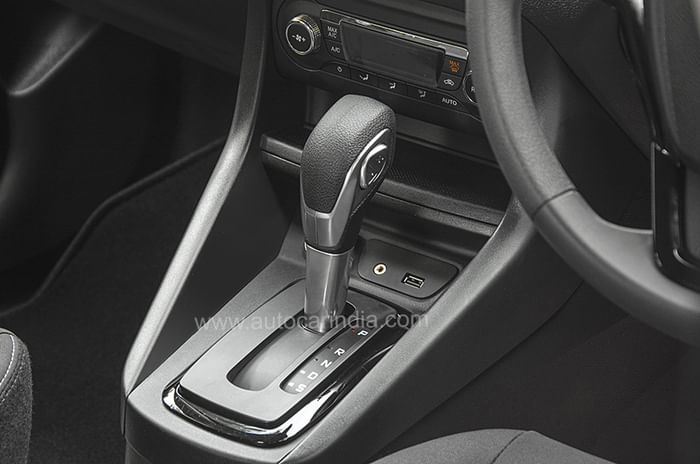
The transmission also gets a Sport mode that keeps the engine in the meat of the powerband. While this Sport mode does make the car feel more responsive to throttle inputs, you’d find it way too aggressive for city commutes. You can take manual control of gear changes in Sport mode via ‘+’ and ‘-‘ buttons on the gear lever. Gear changes are responsive but the buttons themselves feel fiddly and are not as intuitive to use as the tip-to-change mechanisms available on some other cars.
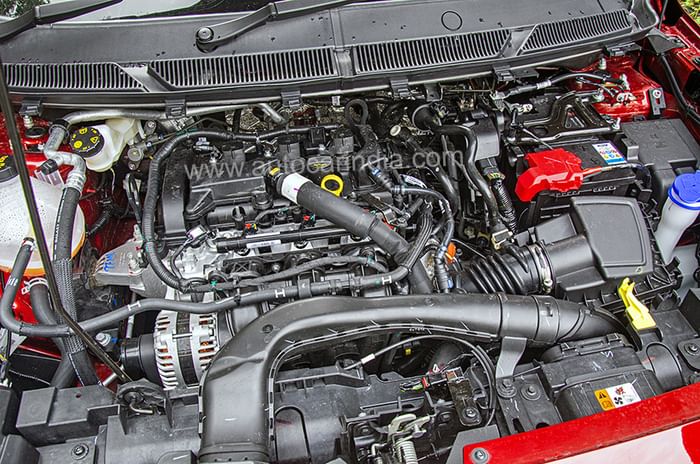
On paper, the Figo’s 1.2-litre, three-cylinder engine is the most powerful naturally aspirated unit in its class, producing 96hp and 119Nm. However, in reality, the way Ford has tuned this engine and gearbox combination, the Figo doesn’t feel as quick as its rivals, especially if you push it hard. We didn’t get to test the Figo automatic to Autocar’s standard, though our preliminary tests showed that it’s almost 1.5sec slower to 100kph than the i10 Nios. The Figo AT actually feels at its best when you drive in a relaxed manner instead of trying to hustle it.
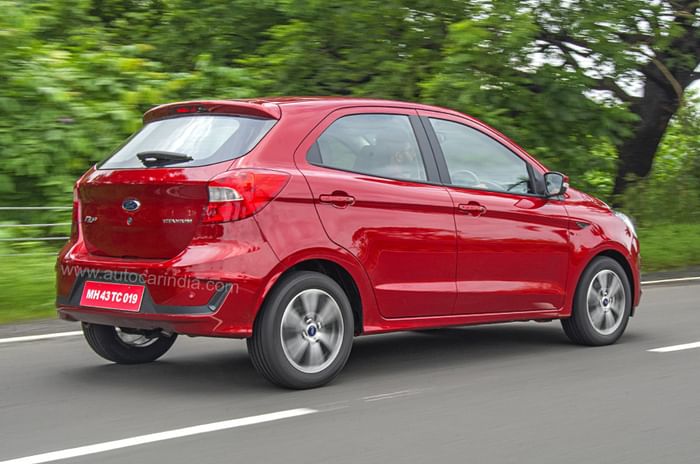
Ford’s three-cylinder engine is quite refined, though you can feel some mild vibrations from the unit at the base of the front seats. It is also worth mentioning that the Figo has quite a fruity exhaust note that is audible from the cabin. While this does add to the Figo’s sporty characteristics, it probably won’t appeal to all buyers.
Ford states that this engine and gearbox combination returns an ARAI fuel efficiency figure of 16kpl. This is 2.5kpl lower than the claimed figure for its manual counterpart (18.5kpl).
2021 Ford Figo automatic: how does it drive?
The Figo has always differentiated itself with its nice-to-drive nature and that holds true even today. The steering feels light at low speeds, aiding its manoeuvrability around town. As you pick up pace, the steering weighs up well and feels very direct and responsive. Show the Figo some corners, and you’ll see that it is quite eager to turn in and change directions. All this gives you a sense of confidence from behind the wheel that few other hatchbacks deliver.
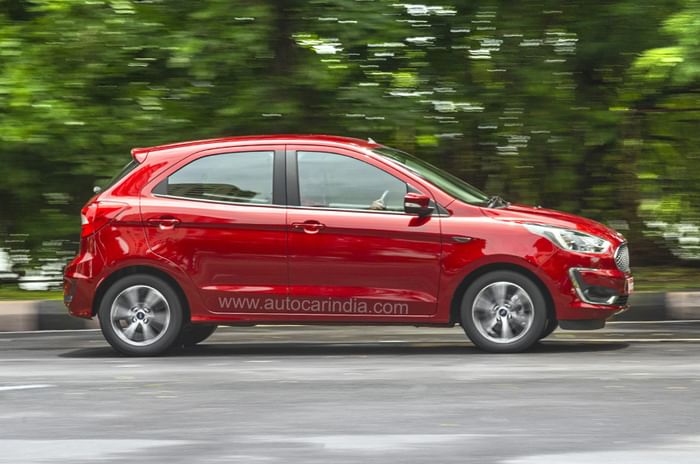
Ride is another area that the Figo excels in. It deals with bad roads without breaking a sweat, as it works silently and irons out all sorts of road imperfection, barring the largest of potholes. The Figo's suspension setup feels very stable at higher speeds and it also has a strong set of brakes that have a very reassuring feel on the brake pedal.
2021 Ford Figo automatic: should you buy it?
The Ford Figo automatic is only available in two trims – Titanium, which is priced at Rs 7.75 lakh (ex-showroom), and Titanium+, which costs Rs 8.20 lakh. At first glance, the Figo Titanium AT might look like the costliest entry-point amongst its rivals, as the Hyundai Grand i10 Nios Magna AMT starts at Rs 6.62 lakh and the Maruti Suzuki Swift VXI AMT starts at Rs 7.01 lakh. However, when you consider that the Titanium is a mid-level variant, its price is much more competitive to its mid-range counterparts – the Nios Sportz AMT (Rs 7.23 lakh) and Swift ZXI AMT (Rs 7.64 lakh). In fact, the top-spec Figo Titanium+ AT even undercuts the price of the range-topping Swift ZXI+ AMT (Rs 8.42 lakh), however it still doesn’t beat the Nios Asta AMT’s Rs 7.86 lakh price tag.

So, should you buy one? The Figo is missing the latest equipment and the package has started to feel a bit long in the tooth now. Yes, this Figo auto promises much, with class-leading power, a relatively sophisticated torque converter gearbox and a keen price tag, but somehow the package doesn’t quite bowl you over.
That being said, the Figo's appeal is in its fun-to-drive nature, strong build and class-leading safety equipment; these have long been the prime reasons to be interested in the Ford hatchback. The new automatic transmission adds in convenience to this list of strengths.






































